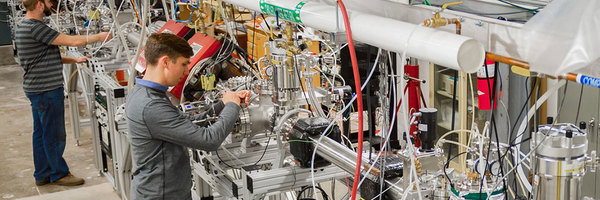
About
Since the late 1930s, the University of Notre Dame has supported an active research program in the fields of low and medium energy experimental nuclear physics. This rich history continues today within the Nuclear Science Laboratory of ISNAP, which is located in Nieuwland Science Hall on the campus of Notre Dame.
The Institute for Structure and Nuclear Astrophysics (ISNAP) operates the Nuclear Science Laboratory at the University of Notre Dame. The laboratory is built around two elecotrostatic accelerators (Sta. Ana and FN) and has a broad program in low energy nuclear physics. These two accelerators offer a wide range of beam energies providing ideal conditions for nuclear structure and nuclear astrophysics experiments. The FN Tandem accelerator operates with a Pelletron charging system at terminal voltages as high as 10.6 MV. The Sta. Ana accelerator provides high beam intensities with terminal voltages of up to 5 MV. We have the capability of producing both stable and unstable beams of various types for research interests including Nuclear Structure, Nuclear Reactions with Radioactive Ion Beams (RIBs), and Nuclear Astrophysics. The laboratory has a large number of national and international user groups including US National Laboratories.
In addition to our basic science interests, we have interdisciplinary programs involving bio-mechanics, materials analysis and radiation chemistry. In collaboration with faculty from Notre Dame's Department of Anthropology, PIXE is used to test archeological samples. We also pursue research with industry, such as the testing of new detectors as well as studies of artificial joint components to measure durability. Our radiation chemistry program revolves around studies of the effects of ionizing radiation on the molecular decomposition of water and various organic materials, including polymers. The practical aspect of this type of work has direct applications to the management of nuclear reactors, and the treatment or storage of radio-active waste media. This work is carried out by the Notre Dame Radiation Laboratory which is funded by the Department of Energy and is an historic outgrowth of the Manhattan project.